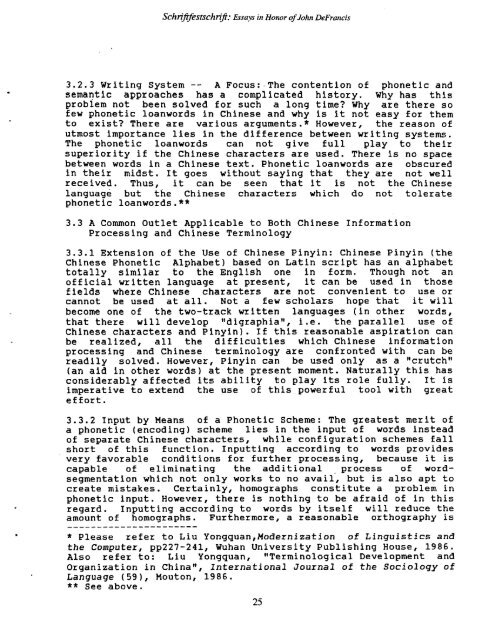Essays on Writing and Language in Honor - Sino-Platonic Papers
Essays on Writing and Language in Honor - Sino-Platonic Papers
Essays on Writing and Language in Honor - Sino-Platonic Papers
You also want an ePaper? Increase the reach of your titles
YUMPU automatically turns print PDFs into web optimized ePapers that Google loves.
Schriifrestschr!: &sap <strong>in</strong> Homr of John DeFrarzcis<br />
3.2.3 <strong>Writ<strong>in</strong>g</strong> System -- A Focus:.The c<strong>on</strong>tenti<strong>on</strong> of ph<strong>on</strong>etic <strong>and</strong><br />
semantic approaches has a complicated history. Why has this<br />
problem not been solved for such a l<strong>on</strong>g time? Why are there so<br />
few ph<strong>on</strong>etic loanwords <strong>in</strong> Ch<strong>in</strong>ese <strong>and</strong> why is it not easy for them<br />
to exist? There are various arguments.* However, the reas<strong>on</strong> of<br />
utmost importance lies <strong>in</strong> the difference between writ<strong>in</strong>g systems.<br />
The ph<strong>on</strong>etic loanwords can not give full play to their<br />
superiority if the Ch<strong>in</strong>ese characters are used. There is no space<br />
between words <strong>in</strong> a Ch<strong>in</strong>ese text. Ph<strong>on</strong>etic loanwords are obscured<br />
<strong>in</strong> their midst. It goes without say<strong>in</strong>g that they are not well<br />
received. Thus, it can be seen that it is not the Ch<strong>in</strong>ese<br />
language but the Ch<strong>in</strong>ese characters which do not tolerate<br />
ph<strong>on</strong>etic loanwords.**<br />
3.3 A Comm<strong>on</strong> Outlet Applicable to Both Ch<strong>in</strong>ese Informati<strong>on</strong><br />
Process<strong>in</strong>g <strong>and</strong> Ch<strong>in</strong>ese Term<strong>in</strong>ology<br />
3.3.1 Extensi<strong>on</strong> of the Use of Ch<strong>in</strong>ese P<strong>in</strong>y<strong>in</strong>: Ch<strong>in</strong>ese P<strong>in</strong>y<strong>in</strong> (the<br />
Ch<strong>in</strong>ese Ph<strong>on</strong>etic Alphabet) based <strong>on</strong> Lat<strong>in</strong> script has an alphabet<br />
totally similar to the English <strong>on</strong>e <strong>in</strong> form. Though not an<br />
official written language at present, it can be used <strong>in</strong> those<br />
fields where Ch<strong>in</strong>ese characters are not c<strong>on</strong>venient to use or<br />
cannot be used at all. Not a few scholars hope that it will<br />
become <strong>on</strong>e of the two-track written languages (<strong>in</strong> other words,<br />
that there will develop "digraphia1I, i.e. the parallel use of<br />
Ch<strong>in</strong>ese characters <strong>and</strong> P<strong>in</strong>y<strong>in</strong>). If this reas<strong>on</strong>able aspirati<strong>on</strong> can<br />
be realized, all the difficulties which Ch<strong>in</strong>ese <strong>in</strong>formati<strong>on</strong><br />
process<strong>in</strong>g <strong>and</strong> Ch<strong>in</strong>ese term<strong>in</strong>ology are c<strong>on</strong>fr<strong>on</strong>ted with can be<br />
readily solved. However, P<strong>in</strong>y<strong>in</strong> can be used <strong>on</strong>ly as a "crutchv'<br />
(an aid <strong>in</strong> other words) at the present moment. Naturally this has<br />
c<strong>on</strong>siderably affected its ability to play its role fully. It is<br />
imperative to extend the use of this powerful tool with great<br />
effort.<br />
3.3.2 Input by Means of a Ph<strong>on</strong>etic Scheme: The greatest merit of<br />
a ph<strong>on</strong>etic (encod<strong>in</strong>g) scheme lies <strong>in</strong> the <strong>in</strong>put of words <strong>in</strong>stead<br />
of separate Ch<strong>in</strong>ese characters, while c<strong>on</strong>figurati<strong>on</strong> schemes fall<br />
short of this functi<strong>on</strong>. Inputt<strong>in</strong>g accord<strong>in</strong>g to words provides<br />
very favorable c<strong>on</strong>diti<strong>on</strong>s for further process<strong>in</strong>g, because it is<br />
capable of elim<strong>in</strong>at<strong>in</strong>g the additi<strong>on</strong>al . process of word-<br />
segmentati<strong>on</strong> which not <strong>on</strong>ly works to no avail, but is also apt to<br />
create mistakes. Certa<strong>in</strong>ly, homographs c<strong>on</strong>stitute a problem <strong>in</strong><br />
ph<strong>on</strong>etic <strong>in</strong>put. However, there is noth<strong>in</strong>g to be afraid of <strong>in</strong> this<br />
regard. Inputt<strong>in</strong>g accord<strong>in</strong>g to words by itself will reduce the<br />
amount of homographs. Furthermore, a reas<strong>on</strong>able orthography is<br />
......................<br />
* Please refer to Liu Y<strong>on</strong>gquan,Modernizati<strong>on</strong> of L<strong>in</strong>guistics <strong>and</strong><br />
the Computer, pp227-241, Wuhan University Publish<strong>in</strong>g House, 1986.<br />
Also refer to: Liu Y<strong>on</strong>gquan, wTerm<strong>in</strong>ological Development <strong>and</strong><br />
Organizati<strong>on</strong> <strong>in</strong> Ch<strong>in</strong>att, Internati<strong>on</strong>al Journal of the Sociology of<br />
<strong>Language</strong> ( 59 ) , Mout<strong>on</strong>, 1986.<br />
** See above.

















